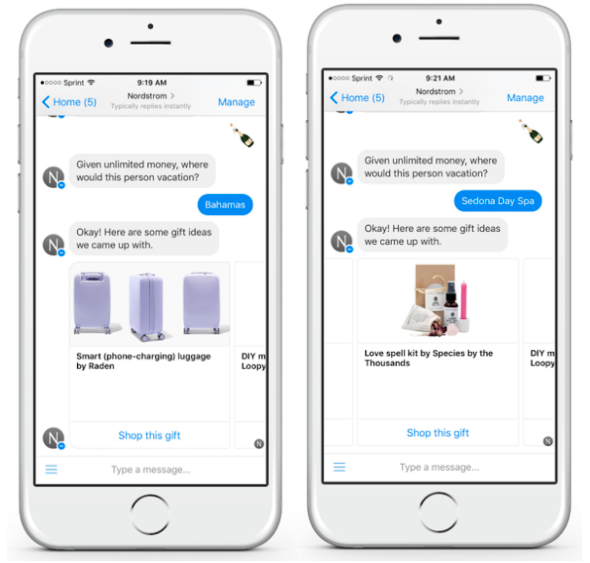
How Chatbots and AI Will Transform Customer Experiences
Increasingly more companies are jumping on the chatbot bandwagon. Designed to mimic conversations with actual humans, there’s more potential to chatbots than meets the eye. Armed with enough data, they have the ability to take customer experiences to a whole new level.
Fueled by AI (artificial intelligence), customer service chatbots are programmed to answer questions and provide guidances. Even though their abilities are limited, their capacity to reshape customer service is undeniable.
Where do chatbots live?
Chatbots live on platforms like Facebook Messenger, WhatsApp, Snapchat and others. They function following a specified set of rules. Basic chatbots can only respond to specific commands they’ve been programmed to perform. Others use machine learning and AI to understand language as well, not just simple commands.
There’s a purpose for a every chatbot. Their aim may be to streamline interaction between people and the services a company provides. But in essence, each handles a different set of tasks, like:
- Facilitate a purchase
- Connect with consumers
- Provide content-based information
- Answer questions
Benefits of chatbots for brands and businesses
Chatbots can save companies money: they eliminate expensive interactions with office-based customer service reps. They streamline simple customer actions because communication with customers occurs in a much more convenient way.
Thanks to AI, chatbots are now smarter and more efficient than ever. Some of the core benefits include:
- 24/7 availability. Banking tasks, online food ordering, and shopping are just some of the areas chatbots excel at. People no longer want to be put on hold when calling a service provider to ask a question, or get clearance of a matter. Furthermore, customers want their needs taken care of at any hour of they day. That’s a service that can’t be provided by conventional customer support representatives.
- Consumer analysis. Chatbots play a fundamental role in customer data analysis. They can be programmed to monitor data and track patterns from consumers. Thus you will optimize your marketing and improve your sales strategy.
- Proactive interaction with consumers. Passive customer interaction is common among most brands. They do respond to complaints or questions, however they rarely reach out to initiate direct contact. Chatbots can be programmed to take the initiative. The action could be something as trivial as asking the customer if further assistance is needed to instil a sense of intimacy.
-
Lead nurturing.
By leveraging the data a chatbot can gather on your customers, you can craft personalized messaging, guiding customers on their “buyer’s journey” and pointing them in the right direction to boost your conversion rates. To make sure your approach is the right one to engage your prospects, do an A/B testing to settle on the types of personalized copies that work best.
Examples of chatbots
On Snapchat, beauty retailer Sephora leverages the power of chatbots via the Kik messaging app. The purpose is to help to streamline communication with prospects and customers by providing support 24/7.
![]()
When prospects access Sephora on Snapchat, they are greeted by a chatbot that tries to engage in a conversation. It provides insights on beauty routines, makeup tips and it can even recommend products based on customer replies.
Another great example of a chatbot is Nordstrom’s mobile bot that helps shoppers find the best holiday gift.
![]()
Developed in collaboration with Snaps , the Nordstrom chatbot provides customized services by engaging with customers and asking them questions related to the gift receiver. Based on the answers, the chatbot provides suitable gift ideas. Driven by AI, the level of assistance chatbots can provide makes the difference between personalized and traditional customer support via phone.
A futuristic chatbot powered by AI
The future looks bright in the world of chatbots. A wealth of industries from social media and management to finance and healthcare are currently implementing chatbots to improve customer service.
![]()
The Ultimate Guide to Chatbots in Business
Learn how chatbots work, what they can do, how to build one – and whether they will end up stealing your job.
Read moreThe futuristic chatbot powered by AI aims to take customer service to a whole new level by accumulating enough data to provide human-like support. Facebook’s AI-powered chatbots have developed a new ability: they can negotiate and create full sentences, rather than just depend on keywords to provide support.
Together with machine learning technology and artificial intelligence, chatbots have the highest chances to become smarter and more targeted at the emotional needs of the people. For companies to leverage a chatbot’s full potential, they should invest more in machine learning infrastructure and gather qualitative data to feed the algorithms that help chatbots improve performance.
Takeaway
Chatbots are a powerful tool that can completely change the way brands and businesses communicate with their consumers. Together with AI, machine learning technology, and the rise of mobile messengers on social platforms, their potential might just persuade companies to think beyond the conventional. Believe that chatbots may someday be able to fulfil a customer’s emotional needs.




